Years ago, when I taught preschool music, I used a book called Piggyback Songs quite a bit. To create a piggyback song, you write new lyrics to a familiar tune (“Twinkle, Twinkle”, etc.). I adopted the name “piggyback” and adapted it for writing. Piggyback Stories is what I call them and kids really do enjoy writing them. ALuv (currently 6.5 years old) has been working on one this week that I wanted to share.
1. First, we read and re-read The Enormous Turnip & The Enormous Watermelon. (This Russian folktale has taken piggyback forms of its own with The Enormous Potato, The Giant Carrot, The Giant Cabbage, etc.)
2. Then, I told him I wanted to see if he could write a piggyback story. What would he call it? “The Enormous ??”. We brainstormed some ideas together-what he could grow and who would be in his story. I wrote down a list for him from our brainstorming session.
3. To help ease his need for perfection the first time (an inherited trait, I’m afraid to say), we discussed a “sloppy copy”.
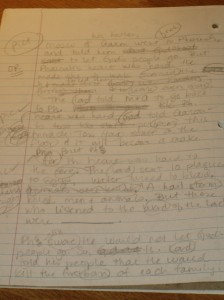 I showed him one of my sloppy copies from the latest Phonics by The Book reader. It blew his mind how messy it was. 🙂
I showed him one of my sloppy copies from the latest Phonics by The Book reader. It blew his mind how messy it was. 🙂
4. He started writing…The Enormous Carrot.
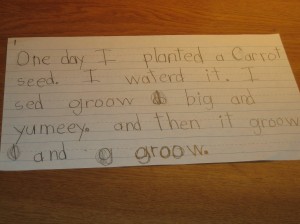 He wrote and wrote and wrote…5 pages with a little extra left over!
He wrote and wrote and wrote…5 pages with a little extra left over!
 He didn’t want to stop. Made my heart proud! (It took him 2 writing sessions to do this, about 45 minutes to an hour total.) I did step in occasionally to help him remember the “rhythm” or structure of the book and apply that to his own writing.
He didn’t want to stop. Made my heart proud! (It took him 2 writing sessions to do this, about 45 minutes to an hour total.) I did step in occasionally to help him remember the “rhythm” or structure of the book and apply that to his own writing.
5. I edited his work. I helped him with conventions (mainly punctuation and capitalization) and some spellings.
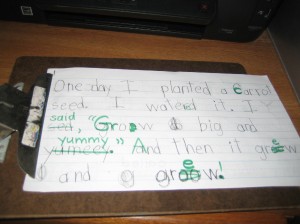 6. He typed his story on the computer (with some help from me). This took 2 days total.
6. He typed his story on the computer (with some help from me). This took 2 days total.
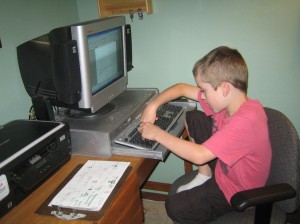 7. We printed it out and he illustrated his story.
7. We printed it out and he illustrated his story.
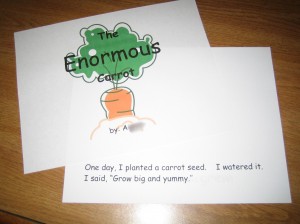 8. We made it into a book! Now, he can add it to his bin of independent readers and re-read it any time he likes! 🙂
8. We made it into a book! Now, he can add it to his bin of independent readers and re-read it any time he likes! 🙂
Some Additional Ideas for “Piggyback” Stories
Folktales make some of the best material for piggyback stories because
- the story structure is predictable in nature (repetitive language; such as The Little Red Hen-“Who will help me?”…”Not I!”…”And she did.”; good always wins; etc.)
- there’s usually more than one version of the story (see the list below)
When you ask a child to write a piggyback story, it helps…
- to read at least two versions of the story to him
- for the child to be very familiar with the story line or structure of the story, so read and re-read the story(ies) several times
- to point out and discuss the predictability of the story with the child. This fosters comprehension (for example, see if he can predict what will happen next).
- to brainstorm ideas together; possibly create one yourself or together first to give the child support
Examples of some folk tales (and their “piggybacks”)
- The Little Red Hen (The Little Red Hen Makes a Pizza, Manana Iguana, It’s my Birthday)
- The Gingerbread Man (The Gingerbread Boy, Gingerbread Baby, The Gingerbread Cowboy, The Stinky Cheese Man)
- Goldilocks and the Three Bears (Believe Me, Goldilocks Rocks!)
- The Three Little Pigs (The Three Pigs, The Three Little Wolves and the Big, Bad Pig)

This post was linked to For the Kids Fridays.
If you haven’t already joined This Reading Mama via RSS Feed, Facebook, Twitter, or email, please do! 🙂
Thanks and God bless,
~Becky
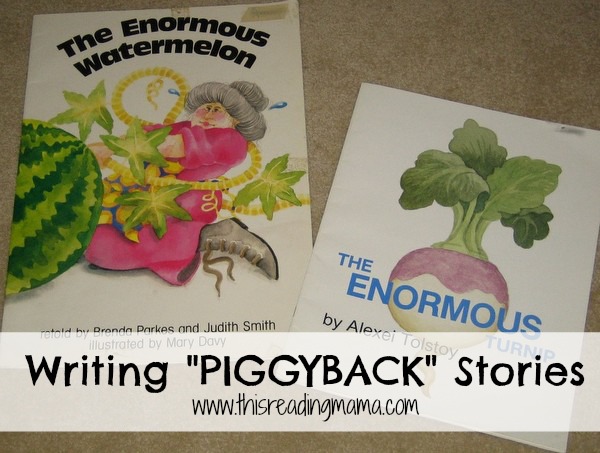
Excellent lesson worthy of professional publication. You are quite a talented curriculum writer and teacher. Carolyn
Thanks, Carolyn!!